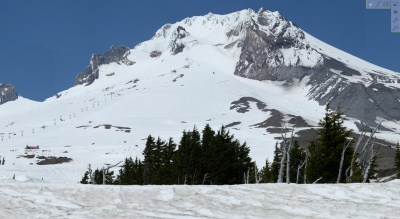
On Memorial Day, I shot my first gigapixel image -- 1.1 gigapixels, to be precise (89,790 x 12,650). You may recognize the view: Mount Hood from Timberline, at the tail end of the ski season. With my telephoto-equipped camera mounted on a tripod, I shot overlapping strips from left to right; top to bottom. 182 frames later, I had the ingredients for a composite photograph composed of over a billion pixels. (Ignore the missing sky segments; apparently the stitching program could not figure out how to assemble featureless colored rectangles into a continuous blank sky. I may be able to figure out a remedy in the future.)
To properly see a gigapixel image, you need a high-res viewer like the Microsoft HD View plug-in for IE. The image sequence below demonstrates a zoom-in from a wide shot showing the Timberline Lodge, all the way in to a trio of snowshoers on the mountain slope:


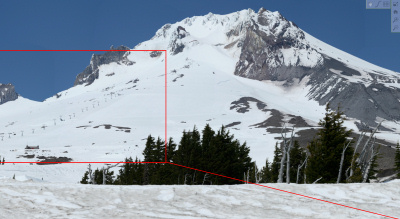
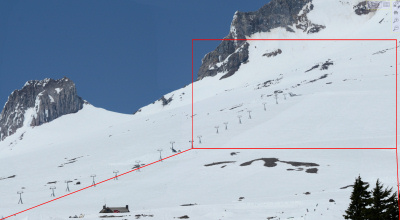


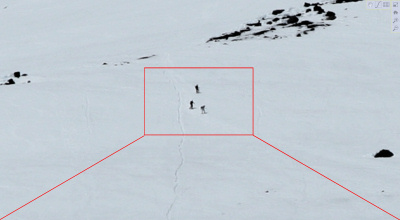
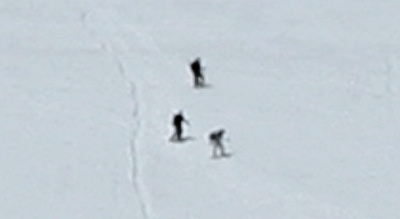
To see this as a full-window zoom-out sequence, click here.
If you have been to my office, the photographic angle for Mount Hood may look vaguely familiar. That's because you have seen it before, on my office wall. In the summer of 2005, I shot a 42-frame, 89.5 megapixel (17,358 x 5,158) composite of Mount Hood from the exact same location. Of course the snow was mostly gone, revealing colorful rocks underneath.

At the time, I was only using a 4-megapixel point-and-shoot digital camera. But IMHO, the composite results were fairly impressive.
To see it properly, you need a viewer. Fortunately, it's in a file format that can be displayed by gigapan.org -- a website dedicated to sharing large-pixel-count photos. To see the 2005 Summer Mount Hood shot in all its zoomable glory, click here.
Unfortunately, I can't yet upload the gigapixel-sized 2009 Spring Mount Hood shot to gigapan.org, since it's not in a file format they accept. I used AutoStitch for the 2005 shot, which outputs to JPEG format. However, the 2009 shot was way too big for AutoStitch -- it seems to run out of memory somewhere around the 150 megapixel range. I was able to achieve gigapixel compositing thanks to David, who pointed me to Microsoft's Research's ICE program (Image Composite Editor). It's free, and it works well for very large images (and small ones too)! Except for one thing. Once the pixel counts get very large, the number of supported file types drops down to only three: 1) TIF, 2) Microsoft's HD View, 3) Microsoft's Silverlight Deep Zoom. None of those are accepted by gigapan.org. So, I can only do the viewing locally on a computer unless I find a hosting service that accepts one of those formats. Or, a new automatic stitching program that outputs something else for large pixel counts.
But no matter what, I have officially joined the Gigapixel World! :-)

No comments:
Post a Comment